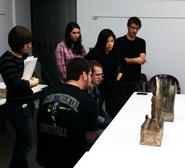
Six students in Thomas Wilson’s seminar, Asian Temples in a Virtual World, travelled to Washington, D.C., from March 8-12 to visit museums in conjunction with their research projects. The trip featured a private viewing of 16 artifacts in the Smithsonian’s Freer and Sackler collections.
The students discussed Buddhist and Taoist stelae from China (ca. 7th-8th centuries CE), which were used in devotional worship. They also viewed two Shang dynasty ritual bronzes dating to about the eleventh century BCE, and 12 scroll paintings, including Buddhist works from Heian (794-1185) and Kamakura (1185-1333) Japan, and Song dynasty (960-1279) China, a nineteenth-century Tibetan mandala, and a Qing dynasty (1644-1911) ancestral portrait of a Manchu prince used in ancestor veneration. This viewing focused on the role of these works of art in ritual contexts.
“It was exciting to be able to look at ancient ritual vessels without a glass pane in the way,” said Linda Yu ’12 “It provided a much more enriching experience in terms of really being able to gain the perspective of someone who actually used the vessel.”
“This was an amazing opportunity to encounter objects in a physical context,” said Eli Remillard ’12. “We were able to gain a better understanding of how these implements were incorporated into ritual activity. I was able to discover an entirely new level of detail by observing these objects up close; a level that was, for me at least, unnoticeable through digital media,” he remarked.
Scott Milne ’14 added, “The trip was a rare and valuable experience. Having the objects in front of us enriched our observations and discussions greatly.”
In addition to trips to Freer and Sackler, the group also went to the National Gallery, where Munson Williams Proctor Art Institute education director April Oswald led a discussion of some Orientalist art in the gallery.
The trip was funded by the Digital Humanities Initiative (DHi) and the Dean of Faculty.
Posted April 3, 2012
